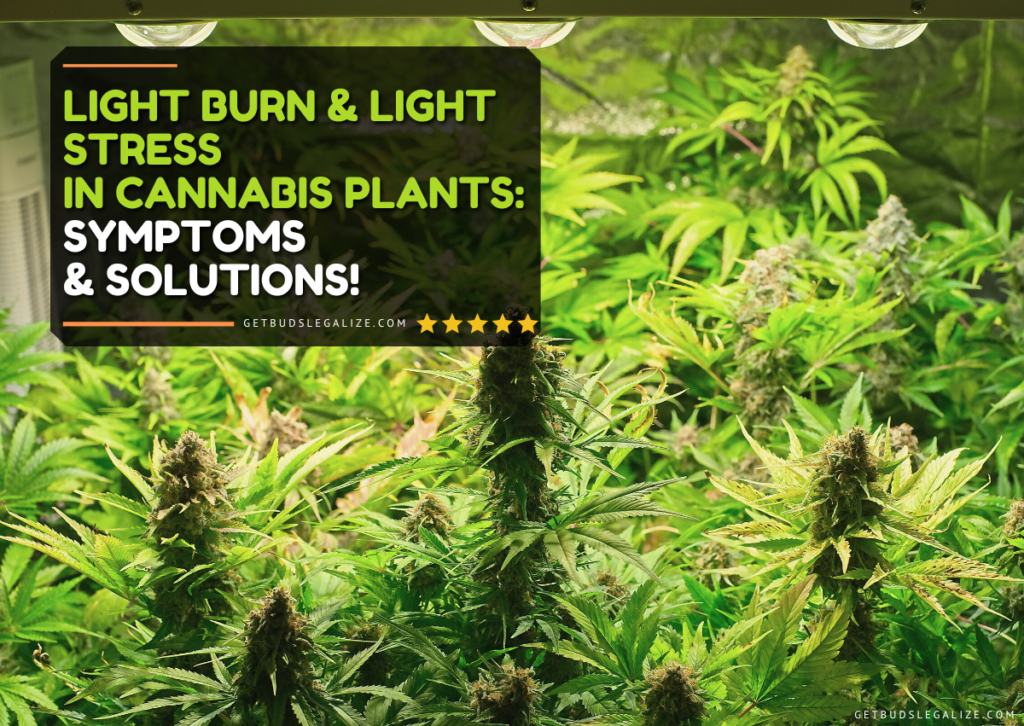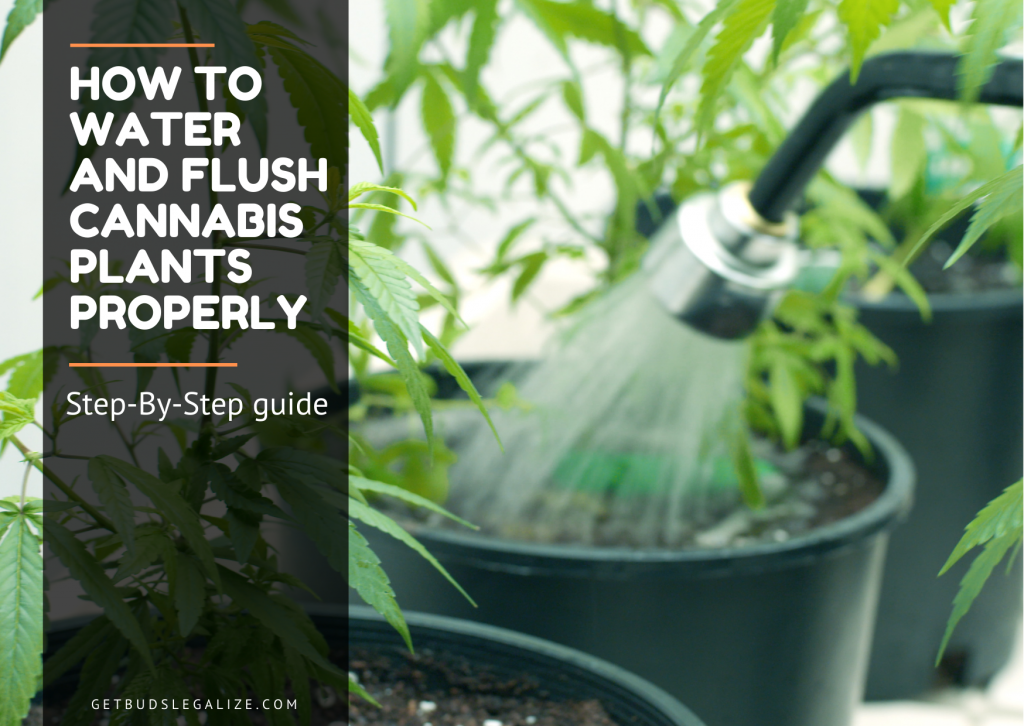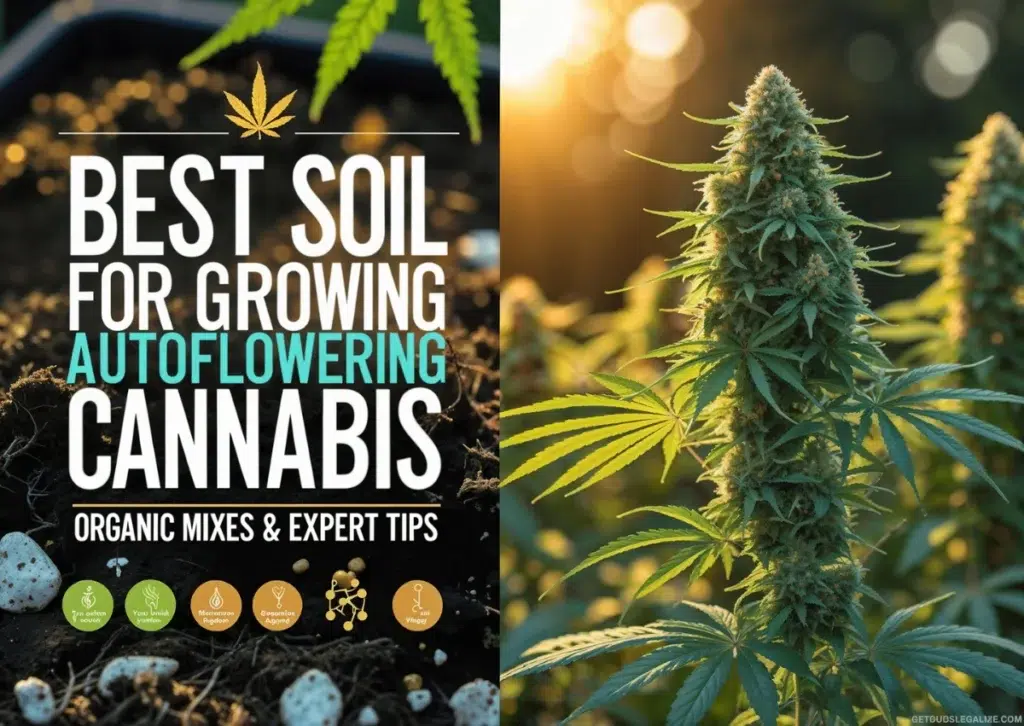Cannabis Heat Stress Guide: Identify, Prevent, and Fix Overheating in Your Plants
Whether you’re growing cannabis indoors or outdoors, managing temperature is one of the most critical—and often underestimated—factors for a successful grow. High heat can silently damage your plants, leading to stunted growth, poor yields, or even crop loss if not addressed in time.
The good news? With the right knowledge and proactive steps, you can recognize early warning signs, understand how overheating affects cannabis physiology, and apply proven techniques to prevent or fix the issue.
In this comprehensive guide, you’ll learn how to spot heat-related stress symptoms, protect your plants from extreme temperatures, and keep your cannabis cultivation on track—no matter the climate.
Table of Contents
- What Is Heat Stress on Cannabis?
- Why Cannabis Overheats: Common Indoor & Outdoor Causes
- What Heat Stress Does to Your Cannabis Plant (Internally)
- Ideal Cannabis Temperatures by Growth Stage (+ Danger Zones)
- How to Recognize Heat Stress at Every Growth Stage
- Outdoor Cooling and Prevention Tips
- Indoor Grow Room Cooling Solutions
- Recovery Tips for Heat-Damaged Cannabis
- Strains Naturally Resistant to Heat
- Final Thoughts
- FAQs
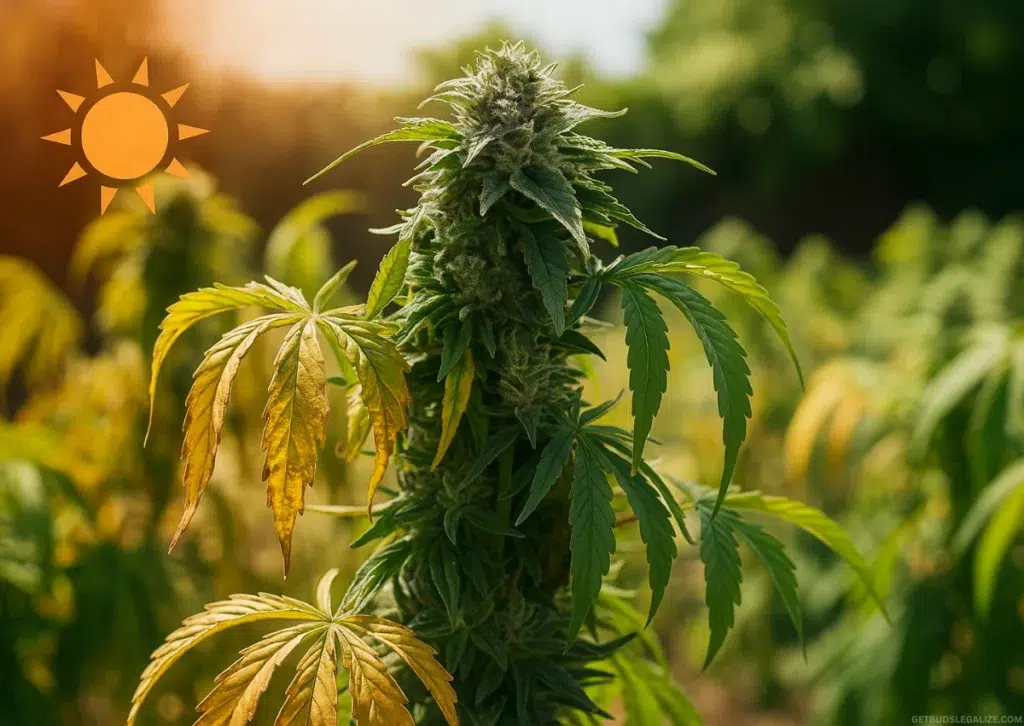
What Is Cannabis Heat Stress?
Before you can prevent heat stress, you need to understand what it is. Cannabis heat stress refers to the damage plants experience when exposed to sustained high temperatures beyond their optimal range. This condition can result in stunted growth, decreased yields, nutrient deficiencies, and even plant death if not addressed in time.
While cannabis is known for its resilience, prolonged exposure to high temperatures can disrupt its ability to photosynthesize, uptake nutrients, and produce high-quality buds. Recognizing the symptoms early and intervening quickly is essential to preserving plant health and harvest quality.
Why Cannabis Overheats: Common Indoor & Outdoor Causes
You might think heat stress only happens in extreme climates or poorly managed grows—but even a well-maintained setup can fall victim to temperature imbalances.
Many growers underestimate how easily environmental factors can push temperatures beyond safe thresholds, especially during peak summer or when ventilation is lacking.
Common Indoor Causes of Overheating:
- Excessive heat from high-intensity grow lights: HID, HPS, and even some powerful LEDs can raise temps dramatically in enclosed spaces.
- Inadequate airflow or ventilation: Without proper air circulation, heat builds up around the canopy and root zone.
- Closed grow tents or small rooms without proper exhaust: Stagnant air traps heat and humidity, stressing your plants.
- High ambient room temperatures: If your grow room lacks cooling support like fans or air conditioning, temps can climb fast.
Common Outdoor Causes of Heat Stress:
- Direct exposure to intense midday sun or heatwaves: Cannabis plants can wilt quickly without protection during temperature spikes.
- Growing near reflective surfaces: Surfaces like white fences, concrete patios, or walls can bounce sunlight and heat back onto your plants, significantly raising the local temperature around them.
- Lack of soil moisture during hot spells: Dry roots make plants more vulnerable to heat-related wilting and leaf damage.
- Hot, dry winds: Wind stress combined with high temperatures can lead to rapid dehydration and leaf curling.
Understanding these triggers helps you design a more robust and climate-resilient grow setup, whether you’re cultivating cannabis indoors or outdoors.
Related Article:
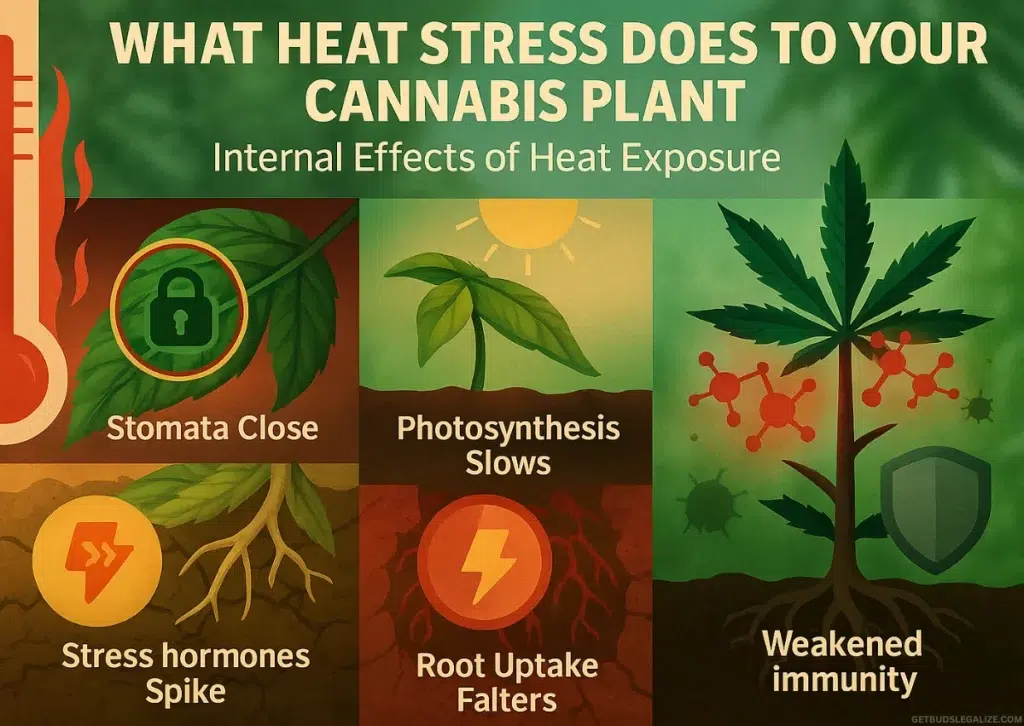
What Heat Stress Does to Your Cannabis Plant (Internally)
To effectively treat and prevent heat stress, it’s essential to understand how it impacts your plants on a biological level.
High temperatures affect cannabis in several interconnected ways.
It’s not just the leaves that suffer—internal functions like nutrient delivery, water circulation, and metabolic balance are also compromised.
Internal Effects of Heat Exposure:
- Stomata Close: The tiny pores on the surface of leaves close to conserve moisture. This reduces CO₂ intake, halting photosynthesis.
- Photosynthesis Slows: With limited CO₂ and water, energy production drops dramatically.
- Stress Hormones Spike: Hormones like abscisic acid signal the plant to enter defense mode, shutting down non-essential growth processes.
- Root Uptake Falters: As transpiration slows, roots absorb less water and fewer nutrients, leading to deficiency symptoms.
- Weakened Immunity: Plants under heat stress are more vulnerable to pests, diseases, and fungal infections.
Understanding these physiological changes highlights why fast action is critical when cannabis temperature stress is suspected.
Related Article:
Ideal Cannabis Temperatures by Growth Stage (+ Danger Zones)
Every stage of cannabis growth has a specific temperature sweet spot. Going even a few degrees beyond can impact development, yield, and potency.
Use the following table as a reference to assess and adjust your grow room or outdoor setup accordingly.
Cannabis Temperature Chart:
| Growth Stage | Ideal Temp (Day) | Ideal Temp (Night) | Too Hot (Risk Zone) | Critical (Danger Zone) |
| Seedling | 20–25°C (68–77°F) | 18–22°C (64–72°F) | 28–30°C (82–86°F) | 32°C+ (90°F+) |
| Vegetative | 22–28°C (72–82°F) | 18–22°C (64–72°F) | 30°C (86°F) | 34°C+ (93°F+) |
| Flowering (Early) | 20–26°C (68–79°F) | 16–20°C (61–68°F) | 28–30°C (82–86°F) | 32°C+ (90°F+) |
| Flowering (Late) | 18–25°C (64–77°F) | 15–18°C (59–64°F) | 27–29°C (80–84°F) | 30°C+ (86°F+) |
| Drying & Curing | 18–22°C (64–72°F) | 18–22°C (64–72°F) | >25°C (77°F) | >28°C (82°F) |
Visual Symptoms of Cannabis Heat Stress in Each Growth Stage
Early detection is crucial to saving your plants and maintaining healthy yields. Your cannabis plants will show warning signs when they’re under thermal stress. Recognizing these symptoms at the right stage helps you take corrective action quickly.
Vegetative Stage Symptoms:
- Leaf Tacoing (Curling Upward): Fan leaves curl along the edges to reduce surface area and limit moisture loss.
- Dry, Brittle Leaves: Leaves lose flexibility, becoming dry and prone to tearing.
- Brown or Burnt Tips: Leaf tips begin to crisp or discolor, often confused with nutrient burn.
- Yellowing at the Margins: Especially noticeable at the top of the canopy closest to the light or sun.
Flowering Stage Symptoms:
- Foxtailing: Buds grow in long, distorted shapes—usually due to intense light or heat.
- Sugar Leaf Curling: Small leaves within the buds curl or dry out, reducing trichome development.
- Reduced Resin Production: Heat interferes with terpene and cannabinoid synthesis.
- Muted Aromas: Heat-sensitive terpenes evaporate or degrade, affecting flavor and smell.
Pro Tip: Combine visual cues with environmental monitoring (thermometers, hygrometers) to confirm the diagnosis and take immediate action.
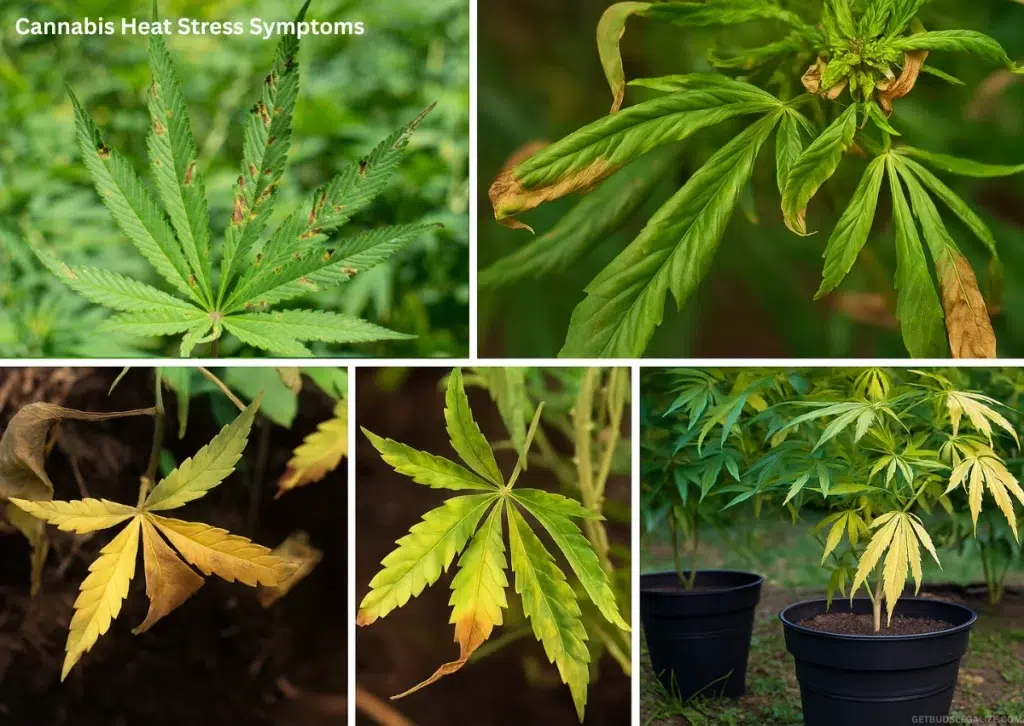
How to Prevent Cannabis Heat Stress Outdoors
While you can’t control the weather, you can equip your outdoor grow to withstand it.
Below are proven, grower-tested techniques to shield your cannabis plants from extreme heat and keep them thriving through the hottest stretches of the season.
✅ Outdoor Heat Protection Techniques:
1. Smart Watering Practices
Watering is your first line of defense against outdoor heat stress. A well-timed hydration strategy keeps your plants healthy and helps prevent wilting, leaf burn, and stunted growth.
- Water in the early morning: Roots can absorb moisture before peak heat, ensuring hydration throughout the day.
- Evening watering (when necessary): Helps replenish lost moisture after a scorching day—but avoid watering too late to prevent fungal issues in humid climates.
- Tailor to your grow setup: Containers dry out faster than raised beds or ground soil. Monitor moisture levels daily during hot spells and adjust frequency accordingly.
2. Mulch for Moisture Retention and Cooling
Mulching is a simple yet powerful way to protect cannabis roots from excessive heat and water loss. It helps insulate the soil, preserves moisture, and creates a cooler microclimate around your plants.
You can use two types of mulch depending on your setup:
- Dead mulch, such as straw, shredded leaves, bark, or compost
- Living mulch, like clover, alfalfa, or chickweed, which also enrich the soil over time
Key Benefits of Mulching:
- Shields the soil from direct sunlight, reducing surface temperatures
- Preserves beneficial microbial activity in the root zone
- Lowers watering frequency by slowing evaporation
Tip: Avoid using hay that contains seeds or herbicide residues—it can introduce weeds or toxic compounds that may stress or harm your cannabis plants.
3. Use Temporary Shade During Peak Heat
A little shade can make a big difference. When the sun is most intense (usually 10 AM–4 PM), provide cover to protect your plants from overheating.
- Use shade cloth, reflective tarps, or even old bed sheets
- Remove the cover after peak heat to restore full sunlight and photosynthesis
- Set up movable frames or stake-mounted canopies for easy adjustments
4. Grow in Portable Containers
Planting in pots gives you flexibility—and control. You can move your plants as needed to avoid heat spikes, sunburn, and hot zones.
Key container-growing tips:
- Use fabric pots: They offer superior airflow and naturally cool the root zone
- Move plants to partial shade: During extreme midday heat, relocate containers under trees, tarps, or shade netting
- Raise pots off hot surfaces: Avoid placing containers directly on concrete or reflective ground, which can heat the roots from below
Portable setups are especially useful in regions with unpredictable summer weather.
5. Minimize Other Sources of Plant Stress
Your plants can only handle so much at once. Avoid high-stress activities—like transplanting or aggressive training—during hot weather.
- Delay topping, fimming, or supercropping until temperatures drop.
- Wait to transplant into final containers or beds during cooler parts of the day.
- Keep handling to a minimum during midday heat.
6. Use Supplements to Boost Plant Resilience
Supplements can help your plants bounce back faster and become more heat-resilient over time.
Recommended Supplements:
- Kelp or Seaweed Extracts: Packed with micronutrients, amino acids, and natural plant hormones that boost overall vigor and help plants bounce back from environmental stress.
- Silicon (Silica): Reinforces plant cell walls, improves water retention, and strengthens your cannabis against both drought and heat extremes.
Apply these supplements once a week or adjust based on your plant’s condition—especially during hot, dry spells.
Related Article:
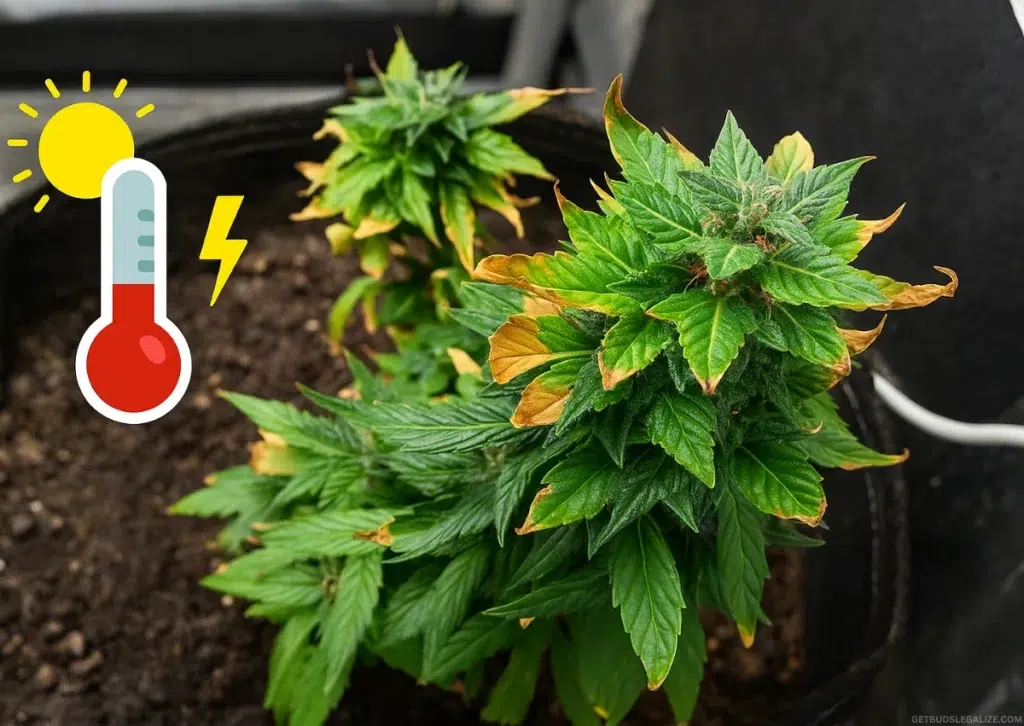
How to Prevent Cannabis Heat Stress Indoors
Indoor grows give you control over the environment, but without proper management, heat can accumulate fast. Lights, enclosed spaces, and insufficient ventilation are the top culprits.
✅ Indoor Climate Control Tips:
1. Optimize Ventilation
Good airflow is critical for removing excess heat and circulating fresh air around your plants. Without it, hot pockets can develop and stress your canopy.
- Use inline exhaust fans to pull hot air out of your grow space.
- Add oscillating fans to improve air movement at the canopy and base.
- Open passive intake vents or use ducting to bring in cooler, CO₂-rich air.
Tip: Create a negative pressure system (more air out than in) to consistently vent heat and odors.
2. Switch to Cooler Lighting
Lighting is one of the biggest contributors to indoor heat. Selecting the right system—and positioning it correctly—can significantly lower the risk of heat stress and light damage.
- LED grow lights produce much less heat than HID or HPS systems.
- Keep lights at least 12–24 inches above the canopy to prevent light burn.
- Monitor leaf surface temperatures using an infrared thermometer for extra precision.
3. Control the Environment
Dialing in the temperature and humidity is key to avoiding cannabis heat stress. You don’t need a professional-grade system—just the right tools and consistency.
- Use portable air conditioners to reduce room temperature.
- Deploy humidifiers or dehumidifiers to maintain ideal RH levels by stage.
- Automate with smart plugs, sensors, and climate controllers to reduce manual guesswork.
4. Use Stress-Reducing Supplements
When heat stress is a risk, strengthening your plants internally can make a huge difference. These natural additives help build resilience and speed up recovery.
- Kelp or Seaweed Extracts: Packed with trace minerals, enzymes, and natural growth hormones that stimulate immunity and stress tolerance.
- Silicon (Silica): Reinforces cell walls, enhances water retention, and increases resistance to heat, drought, and environmental stress.
- Aloe Vera or Coconut Water (for foliar sprays): Gentle, plant-safe ingredients that hydrate and soothe leaves—ideal for helping plants bounce back after a heatwave.
5. Add Mycorrhizal Fungi
This beneficial fungi forms a symbiotic relationship with your plant’s roots, extending their reach and increasing resilience to heat and drought.
- Enhances nutrient and water uptake
- Improves plant stress tolerance
- Easy to apply as a root inoculant during transplant or watering
Bonus Tip: Always monitor your grow room with a digital thermometer/hygrometer combo. Place sensors at canopy level for the most accurate readings.
Related Article:
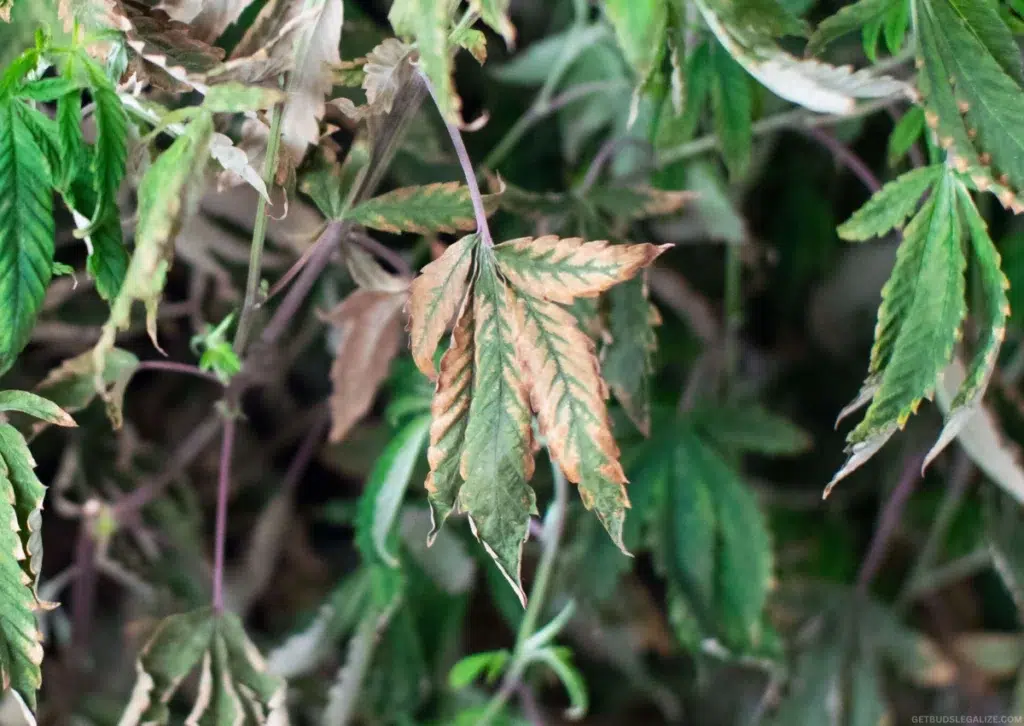
Can Cannabis Plants Recover from Heat Stress?
Yes—and the sooner you act, the better your odds. With quick intervention and proper care, most cannabis plants can bounce back from mild to moderate heat stress. The key is to stop the damage in its tracks and support recovery with minimal disruption.
Plant Recovery Checklist:
✅ Step 1: Remove the Heat Source
Immediately reduce temperatures by relocating outdoor plants to shade or adjusting indoor lights and climate systems.
✅ Step 2: Restore Hydration & Airflow
Increase watering slightly to rehydrate stressed plants and boost airflow using fans or open ventilation points.
✅ Step 3: Minimize Additional Stress
Avoid pruning, defoliation, transplanting, or heavy training while the plant is recovering. Let it stabilize first.
✅ Step 4: Apply Supportive Supplements
Use kelp or seaweed extracts to aid recovery, and apply silicon to reinforce cellular strength and water retention.
✅ Step 5: Monitor New Growth
Keep a close eye on the upper canopy. New leaves should appear healthy, vibrant green, flat, and well-hydrated. If you continue to see curling, discoloration, or drooping, it’s time to recheck your lighting distance, temperature levels, and watering routine to ensure conditions are optimal for recovery.
Pro Tip: Take photos and log symptoms during recovery. This helps identify patterns and prevent future stress episodes.
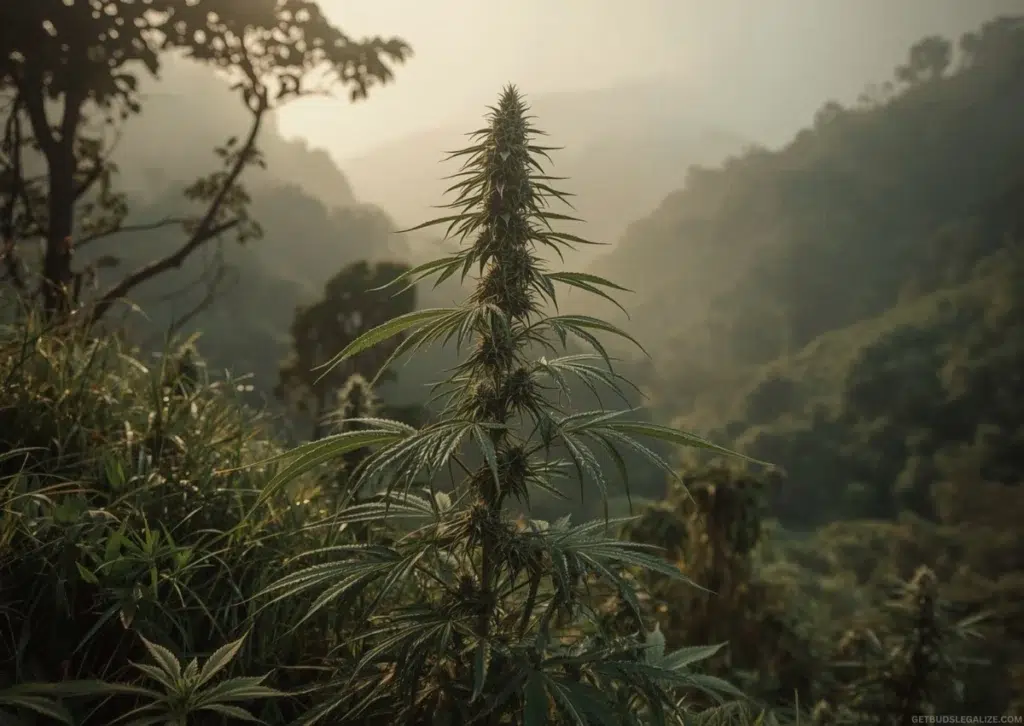
Start Strong: Use Heat-Resistant Cannabis Strains
Preventing heat stress begins with the right genetics. Some cannabis strains are naturally built to handle high temperatures and intense sunlight—thanks to their origins in tropical or arid regions.
These heat-tolerant varieties typically feature thicker leaves, efficient transpiration, and strong drought resistance, making them ideal for hot climate cultivation.
Top Cannabis Strains for Hot Climates:
1. Durban Poison
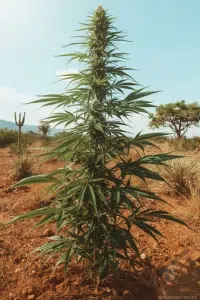
A legendary pure sativa from South Africa, Durban Poison thrives in hot, dry climates. Its tall, lanky frame and vigorous growth make it an excellent choice for full-sun outdoor gardens.
Expect an uplifting, clear-headed high paired with a distinct licorice and spice aroma. Fast-flowering for a sativa, this strain offers strong resistance to pests and temperature swings, making it a go-to option for growers in warm, unpredictable conditions.
2. Afghan Kush
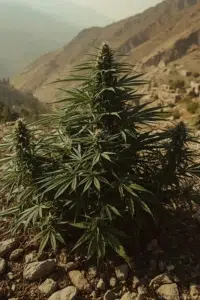
Originating in the arid Hindu Kush mountains, Afghan Kush is a hardy indica built to endure extreme heat and drought.
It features broad fan leaves and dense, resin-heavy buds that deliver deeply sedative effects—perfect for evening use. Known for its resilience and low maintenance, this strain is ideal for beginners and outdoor growers in desert-like environments.
3. Super Silver Haze
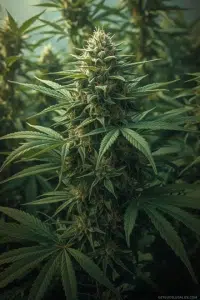
An award-winning sativa-dominant hybrid, Super Silver Haze excels in warm, humid conditions where other strains might struggle. It’s known for combining high-energy effects with the durability and structure of an indica.
Growers appreciate this strain for its heavy resin production, generous yields, and impressive mold resistance, even during heatwaves. Ideal for those looking for a powerful, long-lasting daytime buzz without sacrificing heat performance.
4. Acapulco Gold
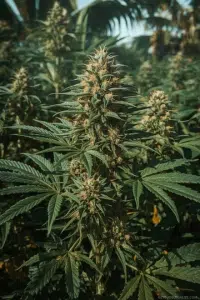
A rare landrace from Mexico, Acapulco Gold excels in hot and humid environments. Its golden-orange buds deliver an euphoric and energetic high.
With natural heat and mold resistance, this strain is a smart choice for growers in tropical climates who want a potent and flavorful harvest.
5. Chocolate Thai
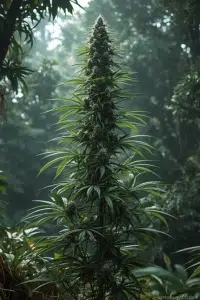
Native to the jungles of Southeast Asia, Chocolate Thai is a true landrace sativa bred by nature to handle jungle heat, heavy humidity, and long seasons.
Though slow to flower and demanding in terms of space and time, Thai Stick rewards experienced growers with towering plants, mold resistance, and a potent, psychedelic high that’s unlike most modern hybrids. Best suited for growers in equatorial climates who want something truly unique.
Grow Tip: Search for landrace genetics or strains bred for “tropical” or “Mediterranean” zones when selecting seeds for hot environments.
Related Article:
Final Thoughts: Don’t Let Overheating Ruin Your Cannabis Grow
Cannabis heat stress can feel overwhelming—but it’s manageable with the right tools, awareness, and planning. From temperature control to strain selection, every decision you make can help your plants stay strong during sweltering conditions.
Don’t wait until symptoms appear. Be proactive. Whether you’re growing in the blazing sun or under grow lights, understanding how to prevent and treat heat stress ensures a healthier crop, higher yields, and better terpene expression.
Stay vigilant. Stay cool. And grow smarter. 🌿
Frequently Asked Questions (FAQs) About Heat Stress on Cannabis Plants
Yes, most marijuana plants can recover from heat stress if it’s addressed quickly. Prompt intervention—like lowering temperatures, improving air circulation, and applying seaweed or silicon-based nutrients—can help your plants bounce back.
However, the longer the stress persists, the harder it becomes for recovery, especially during flowering.
Watch for leaf curling (also called “tacoing”), wilting, dry or crispy edges, and yellowing at the top of the canopy. In more severe cases or during heat stress during flowering, you may see foxtailing buds and decreased resin production—both signs your plant is under duress.
Cannabis heat stress symptoms usually appear when temperatures exceed 30°C (86°F), but critical stress can begin around 32–34°C (90–93°F), especially with poor airflow.
Indoor cannabis setups are more vulnerable to trapped heat, so it’s essential to monitor temps closely.
In both indoor and outdoor cannabis growing, prevention starts with environmental control.
For indoor grows, proper ventilation and air conditioning can make a huge difference.
Outdoors, provide shade during peak sun hours and space your plants well. Smart cannabis cultivation requires constant climate checks and adaptation.
Yes, light stress in cannabis—especially from intense grow lights placed too close—can produce similar symptoms like leaf burn and tacoing.
Always keep lights at the correct distance and monitor plant responses daily.
They can, but recovery is more difficult at this stage. Cannabis is most vulnerable during flowering, and heat stress can permanently impact bud quality and yield.
If detected early, improving conditions immediately and reducing light intensity can help salvage the harvest.
Good airflow regulates temperature and humidity, making it crucial in cannabis growing environments. Use oscillating fans and exhaust systems to prevent stagnant heat and lower the chance of mold or mildew.
Absolutely. When growing cannabis in hot regions, selecting heat-tolerant cannabis seeds is key. Sativa-dominant strains or landraces from tropical climates often handle heat better than others, giving you a natural advantage.
Understanding cannabis plant needs means observing how different cultivars respond to temperature, humidity, and light. Monitor their behavior, learn strain-specific limits, and adjust your growing methods accordingly to ensure optimal results.
ILGM Fertilizer:
Feed Your Plants Right

The Ultimate Cannabis Fertilizer – designed to fuel every stage from seedling to harvest.
✅ Feeds 5+ plants
✅ Big savings with bundle
✅ Works in soil, coco, or hydro
✅ Supports bigger, healthier yields
ILGM Plant Protector:
Ultimate Cannabis Protection

Shield your plants from pests and disease—naturally and effectively.
Protect From Seedling to Harvest
✅ Protects up to 20 plants
✅ Works in soil, coco, or hydro
✅ Fights pests & diseases fast
✅ Keep your grow healthy & stress-free






